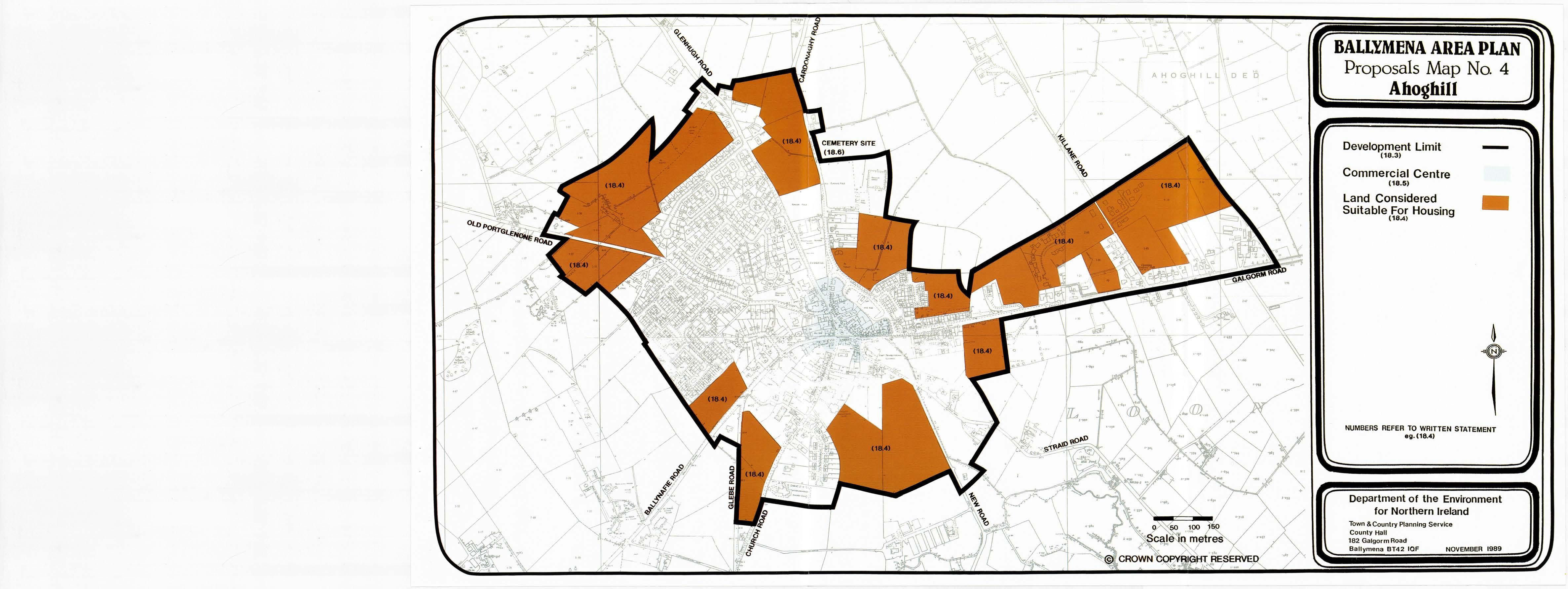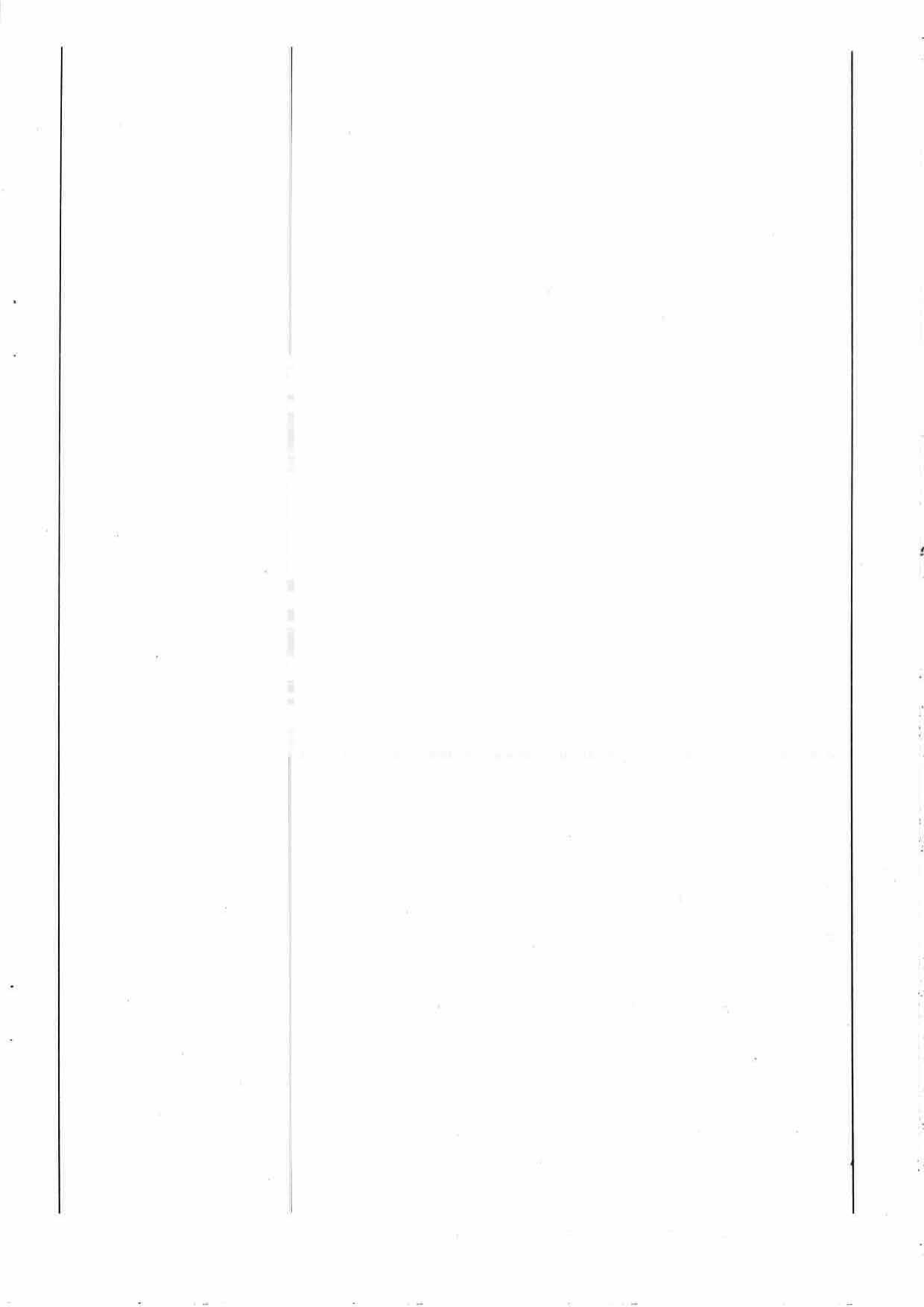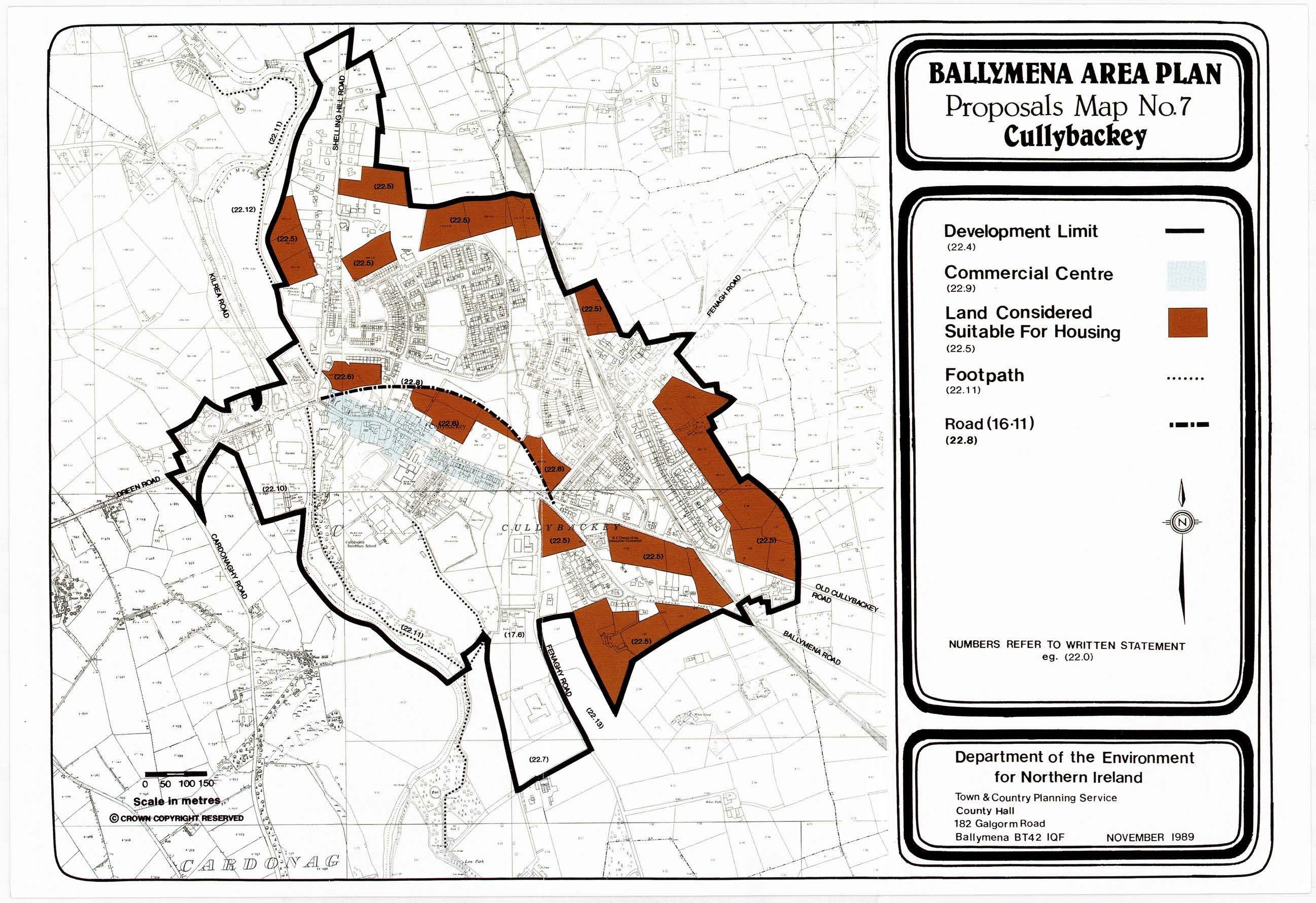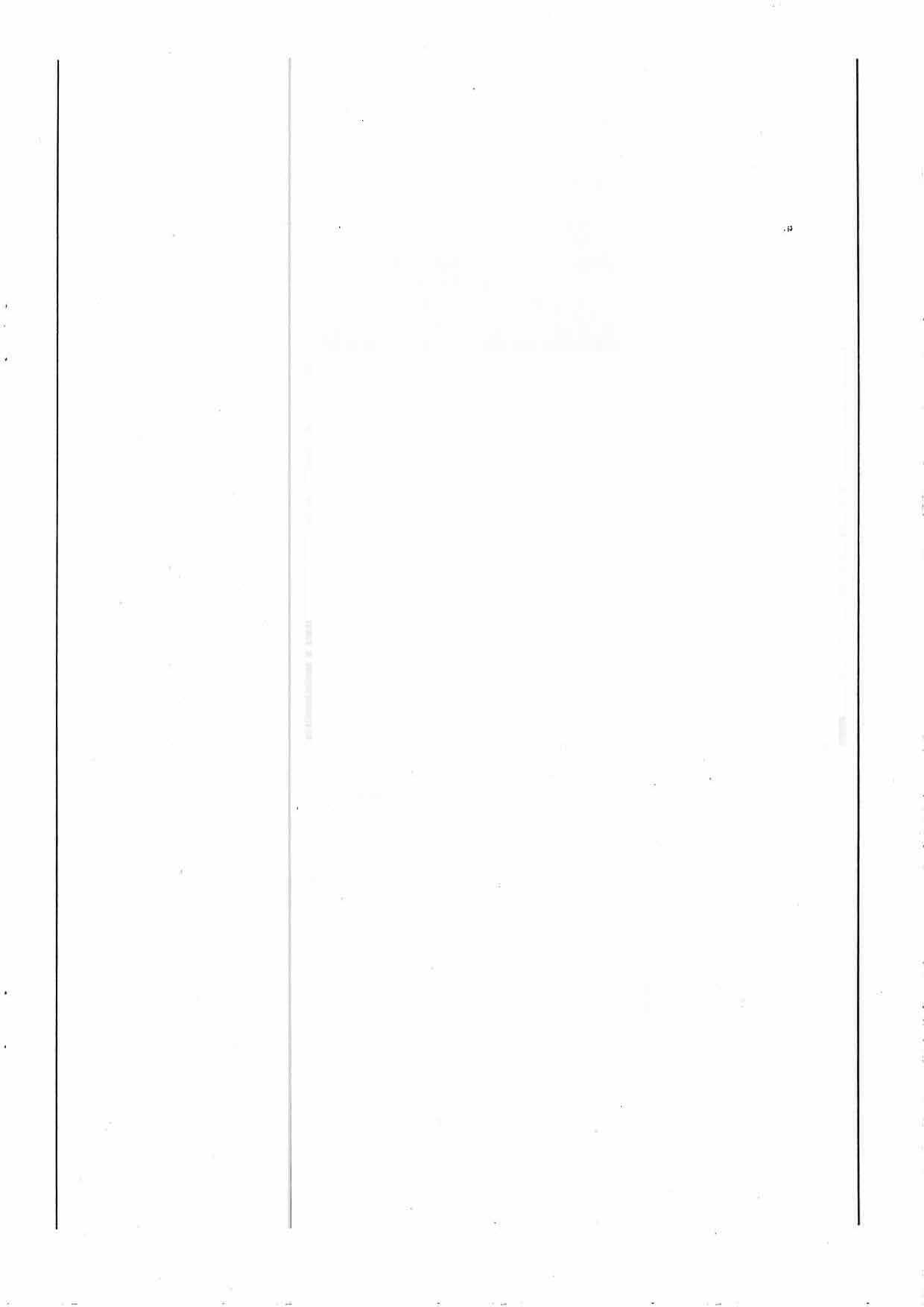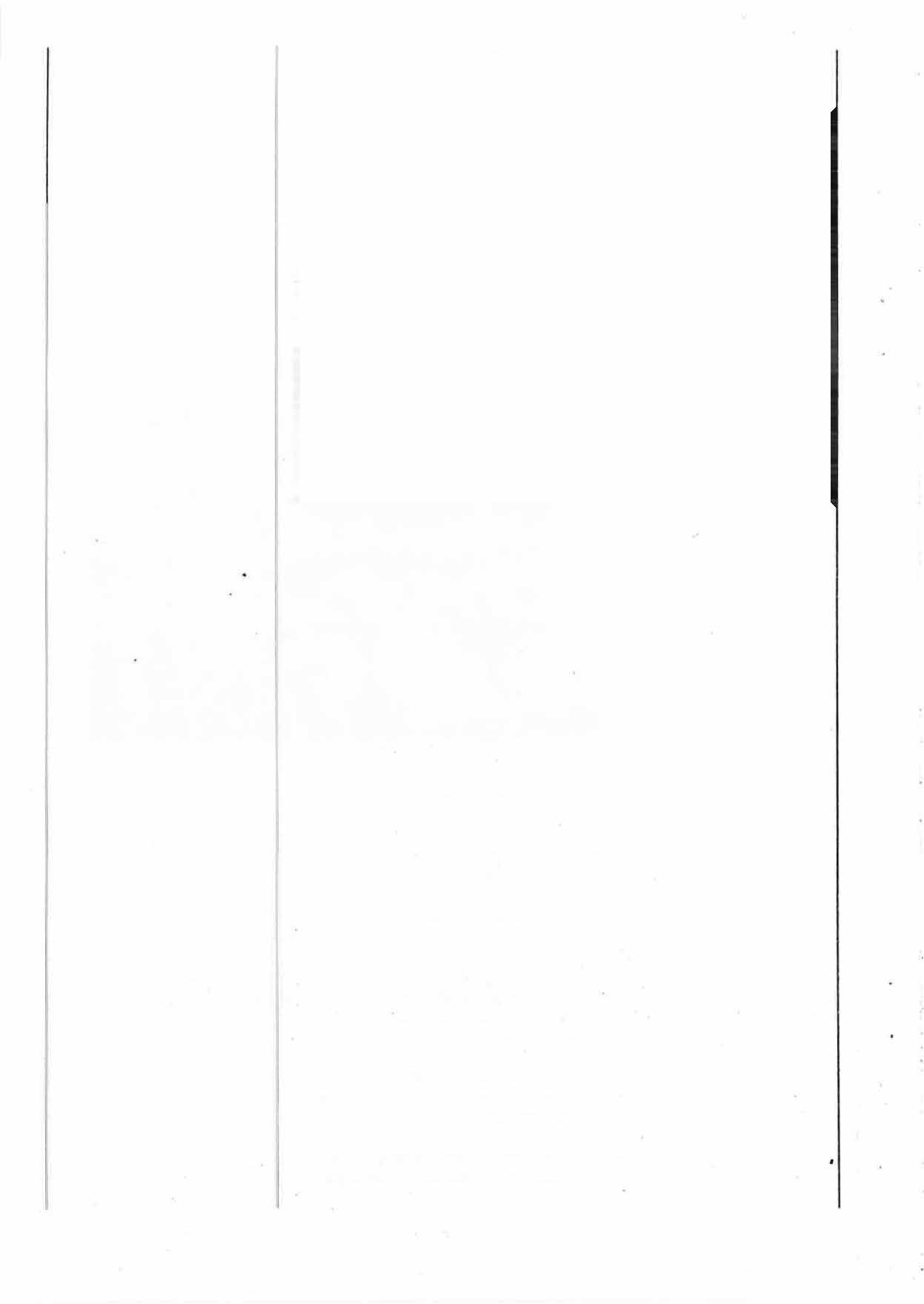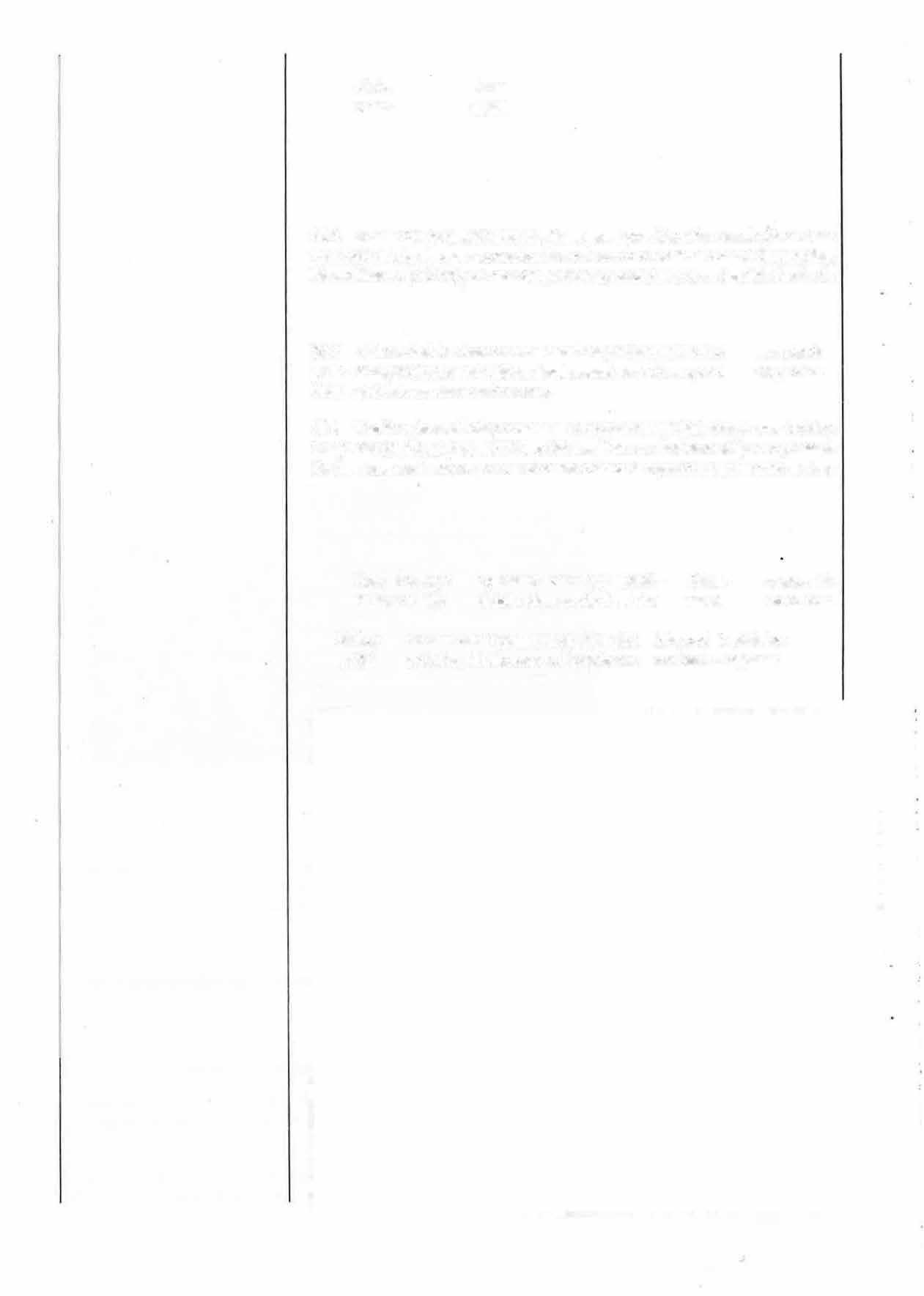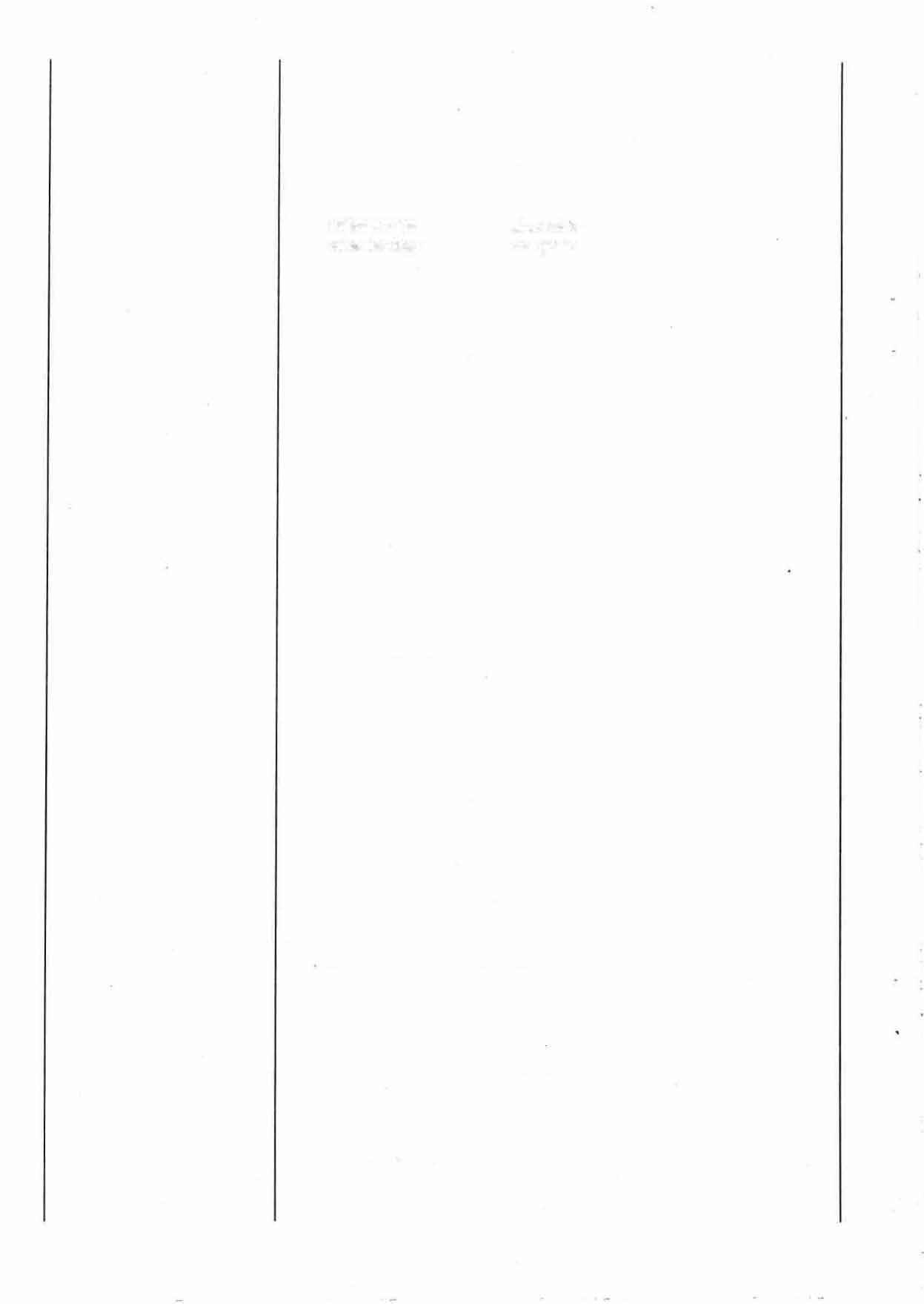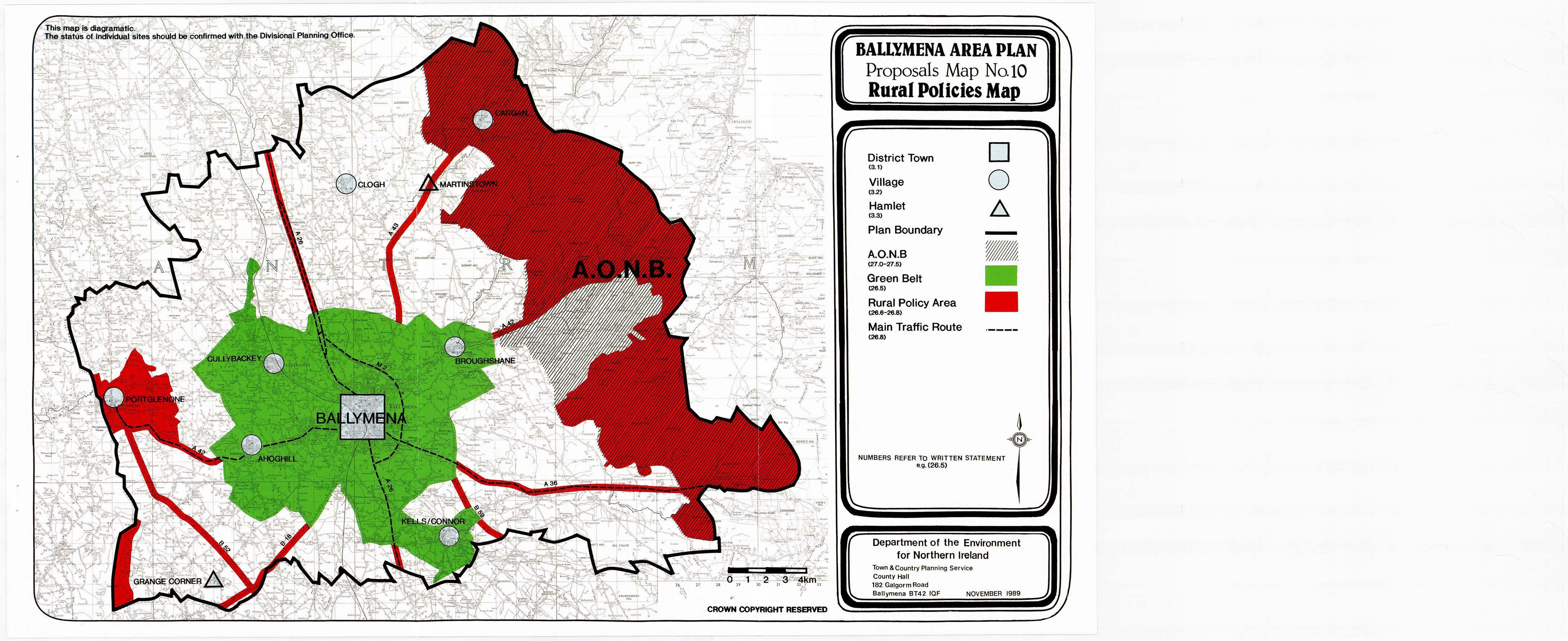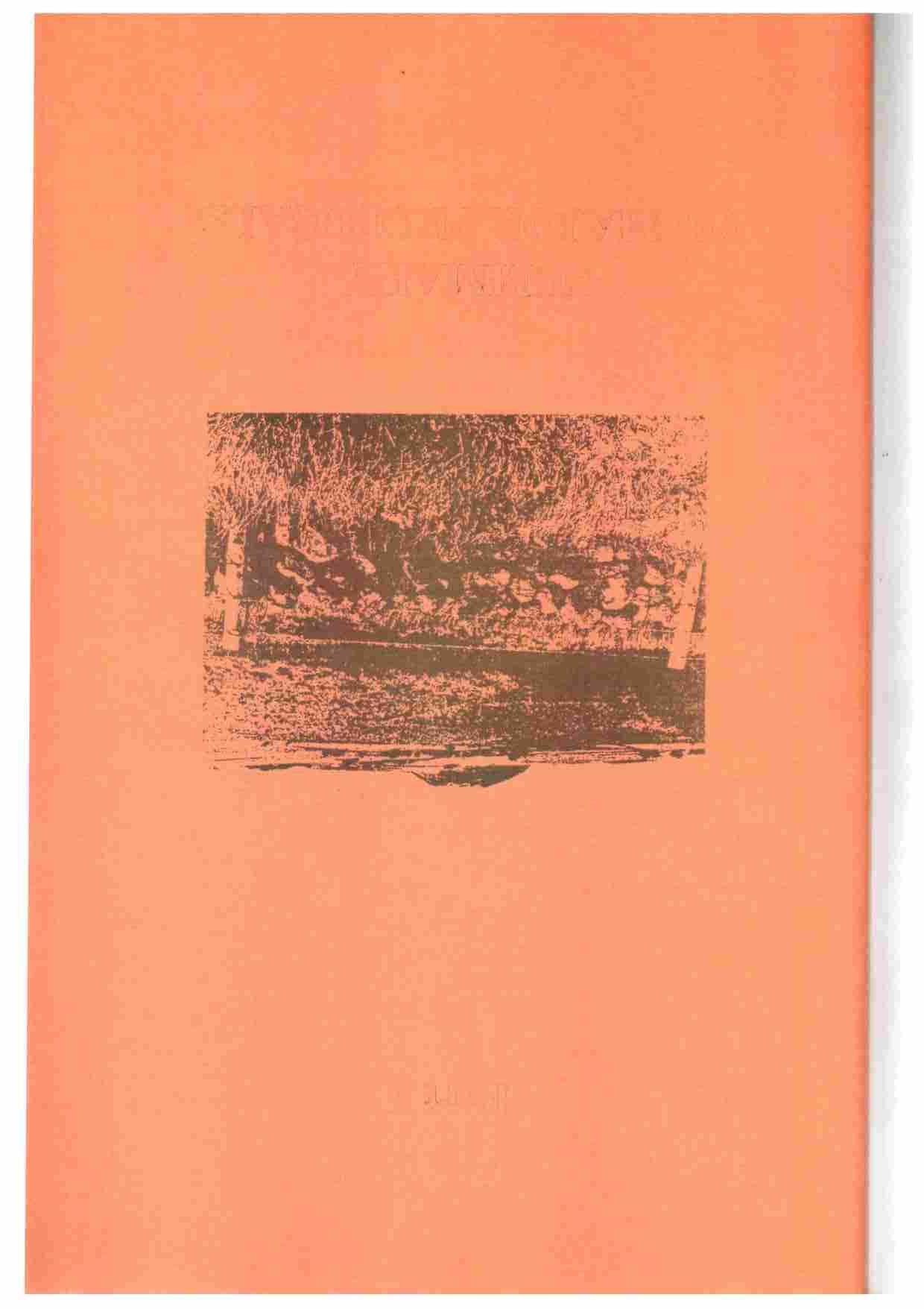






















4.1 The Department aims to ensure that adequate land is made available in each of the settlements lo allow for their continued development and that of the District as a whole Land is zoned for a range of uses including housing, industry and recreation.
4.2 The choice of which land should be included for development in each settlement is a reflection not only of the general aims of the Plan but also of particular local circumst.ances. These include the availability of existing services and the feasibility of adding to them, local topography and the constraints presented by Green Bells or Policy Areas. Account is taken of any planning history such as previous development zonings and planning approvals.
4.3 The scale and distribution of future population change is another issue to be considered when zoning land for development. Population projections include assumptions about future natural increase rates and migration patterns, and cannot be precise. They must not be taken as indicative of what will happen nor do they set any kind of target to be att.ained. Indeed, the development strategy and land use framework cont.ained in the Plan will of themselves exert a positive force on future population levels. What is proposed is a planning framework within which population change can be accommodated, bearing in mind the other development constraints to be considered.
4.4 The population of Ballymena District increased from 49,000 persons in 1971 lo 55,800 in 1985, with the greater part of this growth experienced in the period 1971 to 1975. Ballymena has continued throughout this period to be the principal focus of population growth and in 1986 approximately 57% of the total population in the District lived in the District Town itself.
4.5 The pattern of population growth in Ballymena has been uneven. From the early sixties until the mid-seventies, under the stimulus of direct Government action by the establishment of the New Town Commission, the town experienced a period of rapid growth with the population increasing by approximately 12,000 to 29,000. From 1978 onwards, this growth rate slowed considerably and by 1986 the town population (including Galgorm/Gracehill) had reached approximately 32,500.
4.6 In contrast to most rural areas in Northern Ireland, the population in the remainder of the District, ie outside Ballymena Town, has also increased, albeit at a slow rate. During the period 1971 to 1981, the wards which comprise the villages and rural area grew by 500 persons (2%).
4.7 Ballymena should remain the main centre of population growth, and it is estimated that it could increase from 32,500 in 1986 to 36,100 in 2001. This is based on an assumption of steady growth, with an absence of substantial migration either into or out of the town.
4.8 It is anticipated that the population share of the remainder of the District should remain the same, at 43% throughout the Plan period. The actual population in this section is expected to grow from approximately 23,700 in 1986 to 26,300 in 2001.

5.1 In 1986, there were an estimated 19,000 dwellings in Ballymena District of which approximately 10,500 were in Ballymena Town (including Galgorm/ Gracehill). Many of these dwellings are comparatively new as rates of housebuilding have accommodated population growth and in the twenty years to 1986 approximately 4,500 dwellings were built in Ballymena Town alone.
5.2 Building was at a peak in the late sixties and early seventies when the annual rate in Ballymena was between 400 and 500. It has barely exceeded l 00 dwellings per
year since 1978. Housebuilding in the six main villages has been at a lower rate and has been influenced significantly by development s in the public sector. Between 1974 and 1985 almost 70% of the 800 dwellings built in the se villages were provided by public authorities. In the rural area, housebuilding increased in the 1980s and has been estimated at 80 dwellings per year .
5.3 Dwelling unfitness in the District has been reduced from 16.5 % in 1974 to 9% in 1984 and there has been significant progress in the provision of basic amenities. There is , however, an increasing level of disrepair reaching 24% in 1984 as compared with 19% in 1979. The majority of properties in the poorest condition are isolated, single, rural dwellings in the private sector.

5.4 Over the Plan period, additional housing will be required to accommodate new households and to take account of the continuing trend towards a smaller average household size (ie households will consist offewer persons). Other factors to be taken into consideration are the need to replace existing unfitdwelJings and dwelJings likely to become unfit, to accommodate existing households currently involuntarily sharing dwellings, and to allow for a continuous pool of vacant dwellings to meet the demands of owners moving from one house to another.
5.5 It is estimated that approximatel)l 4,500 dwellings will be required in the District during the Plan period of which up to 2,500 may be built in Ballymena itself. The remainder will be divided between the villages and the rural area, with the housebuilding rate in the latter expected to decrease.
5 .6 In Ballymena over 150 ha (3 70 acres) are zoned for housing and this area could accommodate over 3,000 dwell ings The surplus is provided in ord e r to offe r a d egree of flexibility and choice - an important consideration as it is anti c ipated that growth will be mainly in the private sector. The Department has avoided zoning a few large tracts of land in favour of a greater number of smaller sites
5.7 In the villages, land is not zoned for specific purposes. However, sufficient land is included within development limits to allow each village to fulfil its role within the settlement strategy by providing adequate opportunities for housing developmenL
5 8 In considering the density appropriate to housing areas, the Department will have regard to local conditions including the nature and character of surrounding development as well as the detailed design and layout of the proposed development. The Department will give favourable consideration to high density development in the centre of Ballymena and the villages but will critically examine proposed densities where the adjoining development is low density.

6.1 The number of persons employed in the District gradually rose between 1971 and 1981 from approximately 17,000 to over 19,500. Whilst the unemployment rate rose, the figure remained lower than the Northern Ireland average. The main trends in industry were a decline in the number employed in the manufacturing sector, a significant jncrease in the number employed in the service sector and a decline in the number employed in agriculture. All of these are in line with regional trend.,.
6.2 Ballymena Town has been the main focus of industrial development within the District although a considerable amount ofland previously wned for industry remains undeveloped. Large-scale industry will be encouraged to locate in sites designated in the urban area, and 71 hectares (17 5 acres) of land have been zoned at Galgonn and Woodside Road. This provides ample flexibility and choice fora diversity of industrial uses.
6.3 In all settlements, appropriate small-scale induslrial uses will be welcome on suitable sites. The Department will consider industrial development proposals on merit rather than apply a rigid zoning policy.
6.4 With the decline in manufacturing, several mills in Ballymena and the villages have fallen vacant and in some cases are derelict. These buildings tend to be unsuitable for modem large scale industrial uses and the Department will give favourable consideration to proposals for the rationalisation of vacant mills and other industrial buildings into smaller units for manufacturing, commercial and other uses.
6.5 In the rural areas, permission will normally be given for small-scale commercial and industrial activities in existing buildings such as disused agricultural or

commercial buildings or on derelict sites, provided there are no objections such as unsightliness, noise, smell and excessive or dangerous traffic generation. In these cases there would likely be a strict limitation on further extensions to the project in its rural location.
6.6 Under the Notification of Installations Handling Hazardous Substances Regulations (NI) 1984, a notifiable quantity of Liquified Petroleum Gas is stored at Gallaher's, Lisnafillan. The Department, in carrying out its development control functions, consults with the Health and Safety Inspectorate on development proposals in the vicinity of the installation.
7.1 The Department is responsible for the maintenance and improvement of the 930 kms (578 miles) of public roads in Ballymena District.
During the past 10 years major improvements have been made to roads in the network at:-
A26 North Road, Ballymena
A42 Raceview Road between Ballymena and Broughshane
A42 Galgorm Road at Galgorm
A43 Cushendall Road, Ballymena
C56 Fenaghy Road near Galgorm
UR26 Caminy Road, Ballymena, and URI 12 Woodside Road, Crebilly
7.2 It is envisaged that the following road schemes will be completed during the Plan period to improve the road network:-
A26 Antrim/Ballymena Dual Carriageway (Dunsilly to Bailee)
Ballymena Northern Distributor (North Road to Broughshane Road)
West Link, Ballymena (Ballymoney Road to Galgorm Road) with connection to Old Park Road
South West Ring, Ballymena (Ballee to Galgorm Road)
Woodtown Road, Ballymena
Cullybackey Through Pass
The need for individual elements of the future highway network will be reviewed in the light of actual traffic growth and changing circumstances.
7.3 The dualling of A26 Antrim/Ballymena Road from Dunsilly to Hallee has been confirmed by the Department after Public Inquiry. The scheme will probably be constructed in 4 stages. Stage 1, Dunsilly to Drumkeeran, is programmed to start in Spring 1988.
7.4 In addition the Department will carry out improvement and realignment of sections of the existing road network and further Traffic Management schemes where appropriate. Within the constraints of other priorities and the availability of finance, it will give a high priority to the needs of industrial and housing development.
7.5 Ballymena Town is relatively central to its hinterland and has a spider's web pattern of roads radiating out to the satellite villages and towns both within and beyond the District boundary. Ulsterbus runs regular services from its Galgorm Road Depot to many of these settlements including Ballymoney, Cushendall, Randalstown and Portglenone. There is also a regular bus service linking the main suburban housing estates. Traffic congestion is a problem at certain Limes of the day but the proposed new Northern Distributor should alleviate some of this. Ulsterbu,,; intend to review their services after the Central Area road network is completed and Pedestrian Priority schemes have been implemented.
7 .6 The mainline railway from Belfast to Londonderry passes through Ballymena. There is a main station at Galgorm Road, combined with the Bus Depot, and a subsidiary station at Cullybackey. Northern Ireland Railways have currently no major development plans for the Ballymena District but will be maintaining and upgrading its infrastructure. The Company would respond positively however, to any situation involving co-operation with other bodies to jointly meet a particular demand.
7.7 Ballymena is some 24 km (15 miles) from Belfast International Airport via the A26 and BI 01 roads. Both these roads are to be improved substantially during the Plan period and, thus, journey time to the Airport will be reduced.

8.1 Ballyme~a is the District's principal shopping centre and its position has been strengthened with the opening of the Tower Centre. At present the town contains approximately 91 % of the total nett retail floorspace in the District and its catchment extends beyond the Council boundaries. Demands for additional floorspace will be generated by the increase in the District's population and by any increase in the area's per capita expenditure. However, the existing catchment is unlikely to change significantly within the Plan period as other centres such as Coleraine and, primarily, Belfast will continue to act as strong shopping magnets.
8.2 A Town Centre area has been defined in Ballymena and, while it is difficult to be precise in forecasting future floorspace needs, it is considered that this contains sufficient scope for expansion while retaining a compact and convenient commercial centre. At present this area contains approximately 88% of the total nett retail floorspace in Ballymena Town (80% of the District total). It is the Department's policy to strengthen the dominance of this central area by concentrating future commercial development here. Major commercial and office development will therefore be discouraged outside this area, although some small scale comer shop type units will continue to be acceptable where appropriate.
8.3 Offices will be encouraged to locate in upper floors in the shopping area in order to optimise the use of existing floorspace. In dealing with proposals which would lead to the encroachment of non-retail uses at street level into the main shopping areas the Department will have regard to the likely effect of the loss of retail frontage on the attractiveness of these streets to shoppers.
8.4 In addition to being commercial focii, the central areas of Ballymena and the larger villages are also seen as the entertainment and social centres of these settle- • ments. Therefore, while it is the Department's intention to perpetuate the existing mix of residential and commercial uses, planning applications for restaurants, snooker
rooms, pubs and other entertainment related uses will be sympathetically considered in these areas.

8.5 Retailing and commercial act1V1ty will be strongly resisted in the open countryside as these uses are better located within existing built-up areas.
9.1 The main responsibility for public recreation facilities within the District rests with Ballymena Borough Council. Ballymena, as- the focus of population, has developed a wide range of both indoor and outdoor facilities.
9.2 There is likely Lo be increased demand for such faciliLies over Lhe Plan period and the Council have proposals to:-
(i) develop and extend the amenities in the Civic Park
(ii) create a riverside walk system
(iii) develop a "Trim Trail" and transit caravan park at Bailee Playing Fields. .P
9.3 The level of provision in the villages will be extended by Council proposals to develop riverside footpaths in a numberofthem. lL is also proposed to develop a marina at Portglenone to exploit the potential of the River Bann for pleasure boating.
9.4 Although Ballymena District is not a prime tourist area it is an imporLant link between Greater Belfast and the popular resorts of the North Coast. The ancestral home of US President Arthur at Dreen, near Cullybackey, is one of four such ancestral homes currently being promoted as the focal points of the Ulster American Heritage Trail. Slemish Mountain, Gracehill Village and Portglenone Forest Park also attract visitors into the District.
9.5 The Department will co-operate with all interested parties to highlight and develop tourism in the District. In particular, the main tourist and 'through' routes in the District will be protected from excessive frontage development in order to preserve good views.
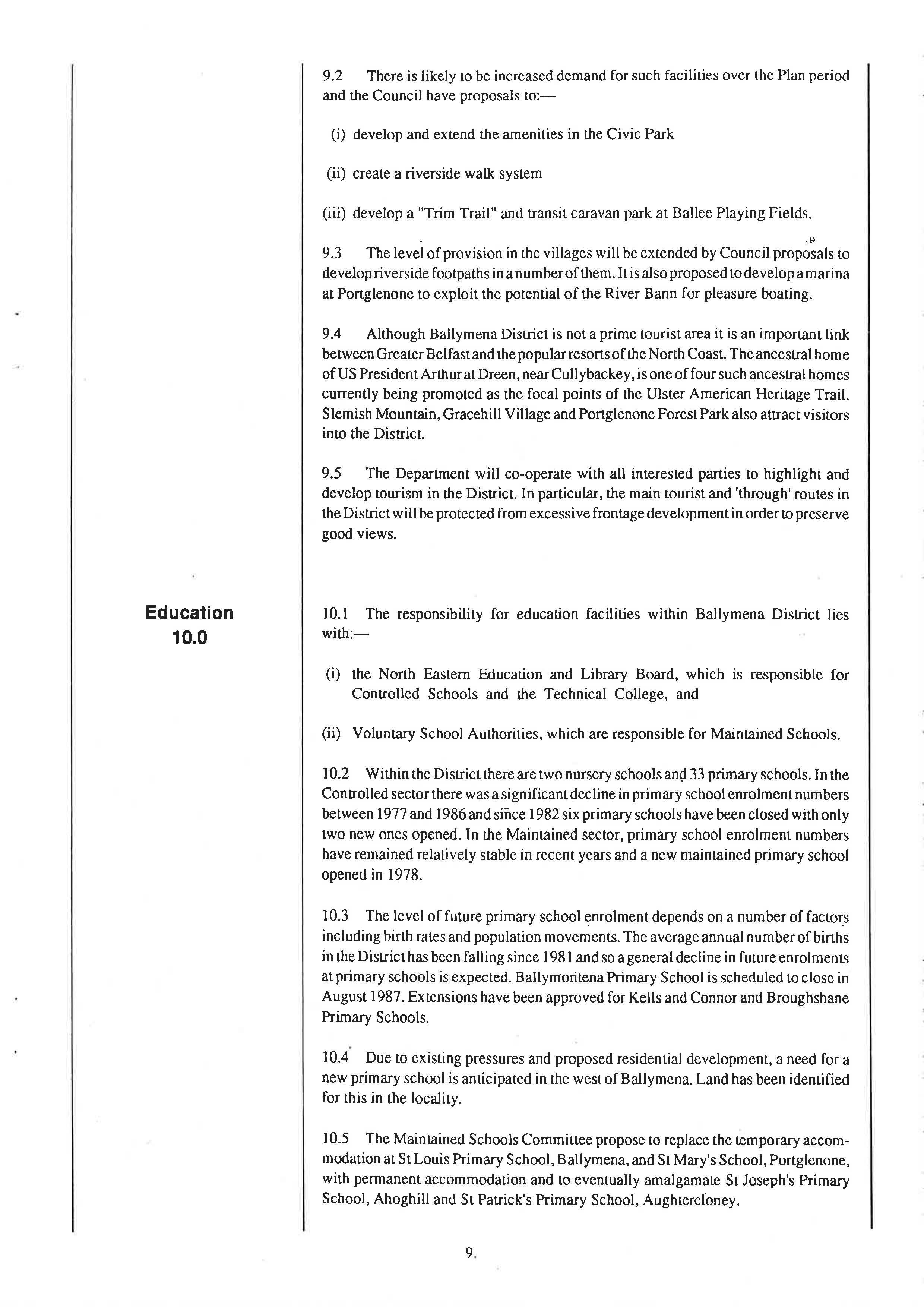
10.1 The responsibility for education facilities within Ballymena District lies with:-
(i) the North Eastern Education and Library Board, which is responsible for Controlled Schools and the Technical College, and
(ii) Voluntary School Authorities, which are responsible for Maintained Schools.
10.2 Within the District there are two nursery schools an<;i 33 primary schools. In the Con trolled sectorthere was a significant decline in primary school enrolment numbers between 1977 and 1986 and since 1982 six primary schools have been closed with only two new ones opened. In the Maintained sector, primary school enrolment numbers have remained relatively stable in recent years and a new maintained primary school opened in 1978.
10.3 The level of future primary school ~nrolment depends on a number of facto~s including birth rates and population movements. The average annual numberofbirths in the District has been falling since 1981 and so a general decline in future enrolments at primary schools is expected. Ballymoritena Primary School is scheduled to close in August 1987. Ex tensions have been approved for Kells and Connor and Broughshane Primary Schools.
10.4 Due to existing pressures and proposed residential development, a need for a new primary school is anticipated in the west of Ballymena. Land has been identified for this in the locality.
10.5 The Maintained Schools Committee propose to replace the temporary accommodation at St Louis Primary School, Ballymena, and St Mary's School, Portglenone, with permanent accommodation and to eventually amalgamate St Joseph's Primary School, Ahoghill and St Patrick's Primary School, Aughtercloney.
10.6 Within the Secondary education sector there are eight Controlled Schools and two Maintained Schools. Secondary School enrolment has increased since 1977 but this recent growth is unlikely to be sustained because Primary School enrolments are falling.
10. 7 The Technical College in Ballymena is based on two separate sites and offers the District a variety of academic and vocational courses.

11.1 The Northern Health and Social Services Board is responsible for Health and Personal Social Services within Ballymena District. The Waveney Hospital in Ballymena is the only general hospital in the District and contained within its complex is the Braid Valley Hospital which caters for geriatric patients. Maternity needs are also catered for at the Cottage Hospital, Ballymena. The Peter Scott Martin House near Cullybackey provides convalescent treatment. There are four Health Centres, located in Ballymena, Ahoghill, Cullybackey and Portglenone and a wide range of community health facilities are provided throughout the District
11.2 In general terms, the NHSSB considers that existing health facilities are adequate for the foreseeable future and has no proposals for future developments in the District
11.3 The North Eastern Education and Library Board is responsible for the existing provision of libraries in the District which comprises a central library in Ballymena and branch libraries in Ahoghill, Broughshane and Bailee, (Ballymena). The Board proposes to extend these facilities by providing a new central lend~ng library in Ballymena with the existing one becoming a reference library. New branch libraries are also proposed in Cullybackey, Kells/Connor and Portglenone.
11.4 Ballymena Borough Council have responsibility for a number of community centres throughout the District and encourage their use by the development of community associations. It proposes to extend this provision by creating community centres in Kells/C~nnor, Gracehill/Galgorm, Cargan, Carniny and in the Ballykeel II housing estate in Ballymena. Those in Gracehill/Galgorm and Ballykeel II will replace the existing temporary buildings.
12.1 The District is fortunate in having a substantial area which is of high scenic quality containing a diversity of habitats within the hinterland of the major settlement. In recognition of this scenic quality the Department has designated a substantial portion of the rural area to the east of Ballymena as part of the Antrim Coast and Glens Area of Outstanding Natural Beauty. The boundary of the AONB is currently in the process of being redrawn by the Department, in consultation with local councils and other interested parties. Within the new boundary the Department will exercise tight control on both the amount and quality of development permitted.
12.2 Nature conservation is achieved both through site and species protection and by the provision ofadvice on the best methods of managing the countryside with nature conservation interests in mind. Under the Nature Conservation and Amenity Lands (Northern Ireland) Order 1985, the Department may establish Nature Reserves and designate Areas of Special Scientific Interest, as well as provide relevant advice.
12.3 To date, no sites have been developed under the new legislation, but under the earlier measure, the Amenity Lands Act (Northern Ireland) 1965, three Areas of Scientific Interest were notified.
1. Lough Beg - An internationally renowned site for its overwintering wildfowl (leading to its designation under the Ramsar Convention on Wetlands as being of international importance) is nationally important because of its summer birds, flora, and other aspects of the fauna
2. Slemish- A tertiary volcanic plug, largely of dolerite, with an associated dyk~ sw.arm. The surrounding grassland contains interesting plant communities.
3. People's Park - A lake with wildfowl of local interest

I 2.4 Under the new legislation it is expected that several Areas of Special Scientific Interest will be declared. There is no change of land ownership involved in such declarations and control of access remains with the landowner.
12 5 Within the District there are approximately 600 features of archaeological' interest though the majority are now only visible as soil or crop marks. One site, 11.
Harryville Motte and Bailey, is in State Care and seven are scheduled for protection under the Historic Monuments (Northern Ireland) Act 1971. The work of scheduling is ongoing and the fact that a site has not yet received statutory protection does not diminish its archaeological importance or its significance as an element in the historic landscape. In dealing with proposals for development the Department will have regard to safeguarding the features of the historic landscape including historic sites and monuments.
12.6 Some 144 buildings and structures of architectural or historic interest throughout the District have been listed by the Depar)-ment under Article 31 of the Planning (Northern Ireland) Order 1972. In dealing with proposals for development the Department will take into account the direct and indirect effects on any listed building with the aim of protecting its character.
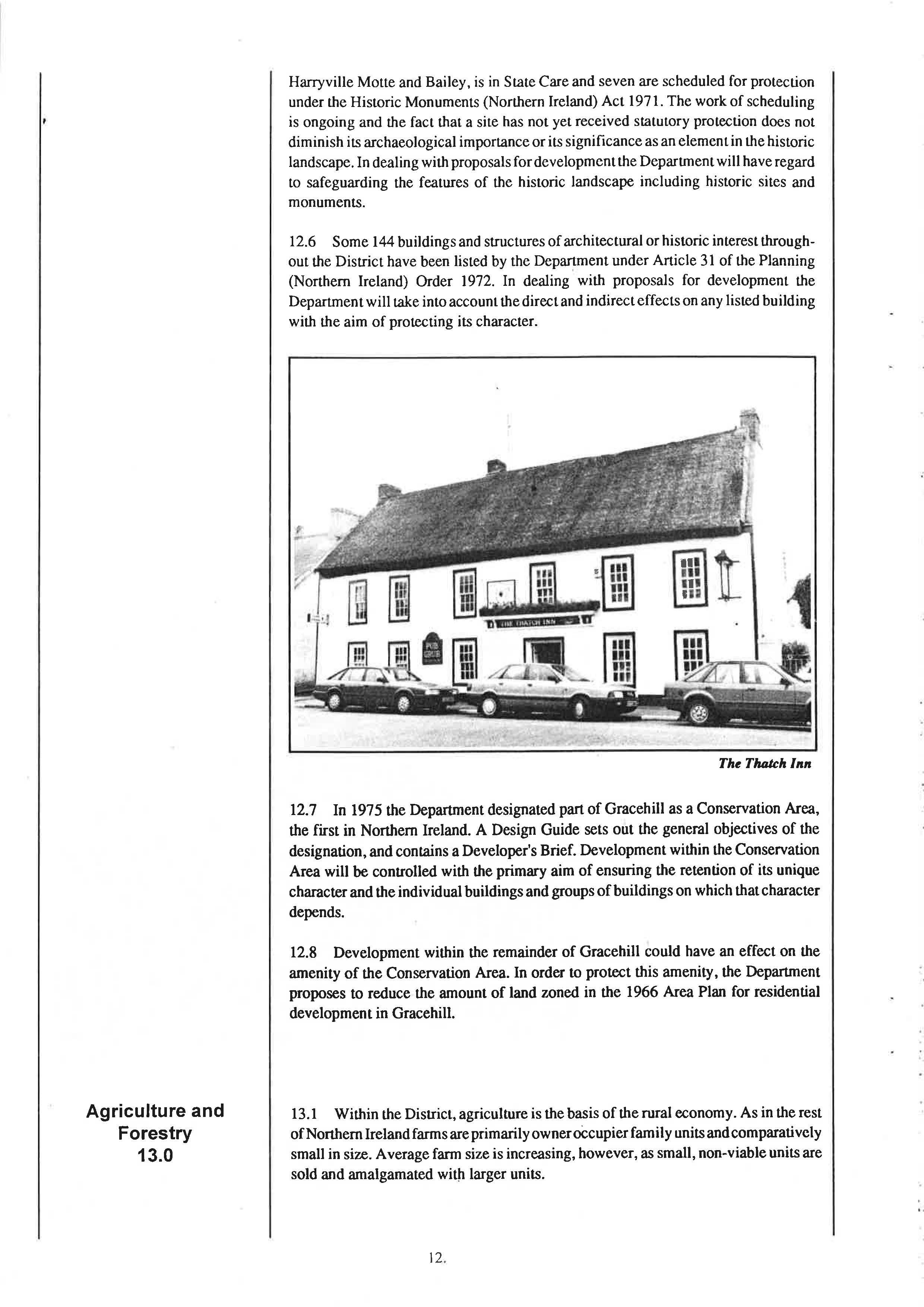
12.7 In 1975 the Department designated part of Gracehill as a Conservation Area, the first in Northern Ireland. A Design Guide sets out the general objectives of the designation, and contains a Developer's Brief. Development within the Conservation Area will be controlled with the primary aim of ensuring the retention of its unique character and the individual buildings and groups of buildings on which that character depends.
12.8 Development within the remainder of Gracehill could have an effect on the amenity of the Conservation Area. In order to protect this amenity, the Department proposes to reduce the amount of land roned in the 1966 Area Plan for residential development in Gracehill.
13.1 Within the District, agriculture is the basis of the rural economy. As in the rest of Northern Ireland farms are primarily owner occupier family units and comparatively small in size. Average farm size is increasing, however, as small, non-viable units are sold and amalgamated with larger units.
13.2 The District contains much high quality arable land particularly in the valleys of the Braid and Main rivers where potato growing is important. In determining which land to designate for development on the fringes of settlements, the Department has endeavoured to avoid good quality land, so that it can remain in agricultural use.
13.3 A relatively small areaofthe District is covered by forests with Portglenone and Cleggan being the two most significant. Increased emphasis is being placed on the recreational use of forests and a car park and walks have been provided al Portglenone. Private forestry is being encouraged with increased grants offered for planting and maintenance.

14.1 Within the District extraction activities fall into three categories:-
! the quarrying of aggregates;
2 the open cast working of bauxite;
3 the cutting of peat.
14.2 The production of aggregates and building stone makes an important contribution to the economy by providing essential construction materials and employment.
Crushed rock aggregates form the bulk of material extracted in the District and there are five hard rock quarries currently operating at Ballylig near Btoughshane, Clinty near Ballymena, Jockeysquarter near Glenwherry, Ballynulto and Tully/Cross. All five are operating with planning permission; a further four sites have consent for 'mineral extraction but are currently inactive.
14.3 With the exception of some minor variations annual mineral production has shown an overall increase from approximately 0.33 million tonnes in 1973 to just over one million tonnes in 1985. The hard rock quarries atClinty, Jockeysquarter and Tully/ Cross were responsible for the bulk of production over this period. The local trend in mineral production contrasts with the province-wide decline over the same period.
14.4 Quarrying activities by their nature, however, can cause significant environmental problems and in deciding planning applications for quarry development the Department will attempt to balance the economic benefits of the proposals with the need to minimise environmental disturbance.
14.5 Although the choice of quarry sites is influenced by geology and proximity to markets, they should ideally avoid prominent locations and proximity to residential developments. Conversely; land uses which are incompatible with quarry operations will normally be discouraged in proximity to approved quarry areas where their presence might prejudice necessary quarry operations or where those operations would be likely to cause nuisance to the development proposed.
14.6 Where the Department grants planning permission for quarry development the permission will be subject to conditions designed to minimise environmental impact. The extent, direction and method of working, and the positioning of ancillary plant and buildings may be stipulated and, where appropriate, controls will be placed on the use of blasting.
14. 7 Planning permission will also stipulate the measures to be taken to restore a site. The objective of restoration conditions will be to ensure that sites are either made capable of productive use after ex traction has ceased or at least are cleared of plant and ' buildings and tidied to avoid dereliction.
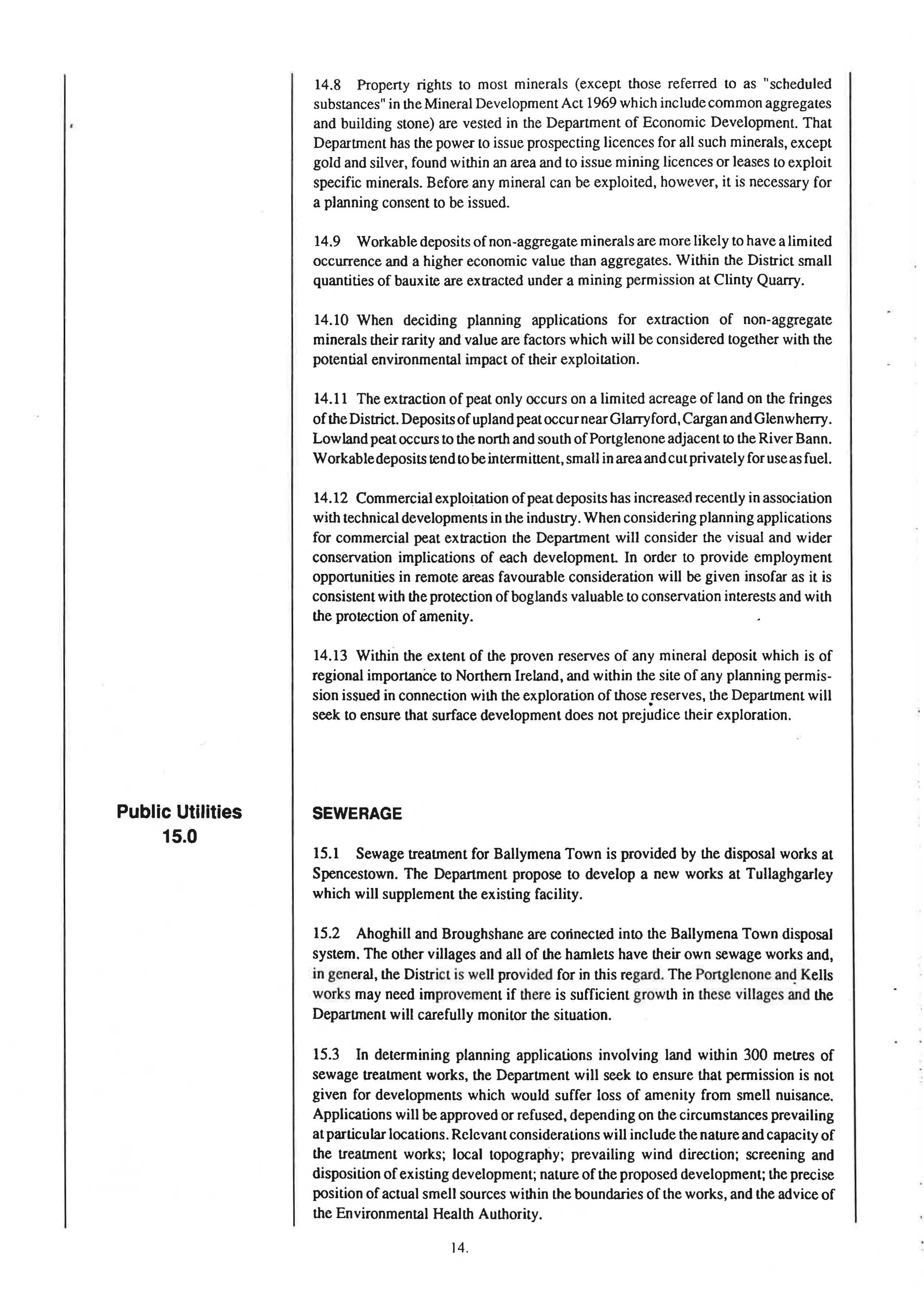
14.8 Property rights to most minerals (except those referred to as "scheduled substances" in the Mineral Development Act 1969 which include common aggregates and building stone) are vested in the Department of Economic Development. That Department has the power to issue prospecting licences for all such minerals, except gold and silver, found within an area and to issue mining licences or leases to exploit specific minerals. Before any mineral can be exploited, however, it is necessary for a planning consent to be issued.
14.9 Workable deposits of non-aggregate minerals are more likely to have a limited occurrence and a higher economic value than aggregates. Within the District small quantities of bauxite are extracted under a mining permission at Clinty Quarry.
14.10 When deciding planning applications for extraction of non-aggregate minerals their rarity and value are factors which will be considered together with the potential environmental impact of their exploitation.
14.11 The extraction of peat only occurs on a limited acreage of land on the fringes of the District. Deposits of upland peat occur near G larry ford, Cargan and Glen w herry. Lowland peat occurs to the north and south of Portglenone adjacent to the River Bann. Workable deposits tend to be intermittent, small in area and cut privately foruseas fuel.
14.12 Commercial exploitation of peat deposits has increased recently in association with technical developments in the industry. When considering planning applications for commercial peat extraction the Department will consider the visual and wider conservation implications of each development. In order to provide employment opportunities in remote areas favourable consideration will be given insofar as it is consistent with the protection of bog lands valuable to conservation interests and with the protection of amenity.
14.13 Within the extent of the proven reserves of any mineral deposit which is of regional importance to Northern Ireland, and within the site of any planning permission issued in connection with the exploration of those !eserves, the Department will seek to ensure that surface development does not prejudice their exploration.
15.1 Sewage treatment for Ballymena Town is provided by the disposal works at Spencestown. The Department propose to develop a new works at Tullaghgarley which will supplement the existing facility.
15.2 Ahoghill and Broughshane are connected into the Ballymena Town disposal system. The other villages and all of the hamlets have their own sewage works and, i.n general, the District is well provided for in this regard. The Portglenone an~ Kells works may need improvement if there is sufficient growth in these villages and the Department will carefully monitor the situation.
15.3 In determining planning applications involving land within 300 metres of sewage treatment works, the Department will seek to ensure that permission is not given for developments which would suffer loss of amenity from smell nuisance. Applications will be approved or refused, depending on the circumstances prevailing at particular locations Relevant considerations will include the nature and capacity of the treatment works; local topography; prevailing wind direction; screening and disposition of existing development; nature of the proposed development; the precise position of actual smell sources within the boundaries of the works, and the advice of the Environmental Health Authority.

15.4 Mains water is available throughout the District and is supplied from boreholes at Bellaghy, Glarryford and Buckna, together with Quoile and Killylane Reservoirs and Dungonnell Dam. Dunore Point, which takes water from Lough Neagh, also contributes to the supply system. Many areas can be supplied from a numberof sources The Department is currently examining means to supplement the existing provision.
15.5 The distribution system throughout the area is generally good and is based on -~ a large number of service reservoirs. New service reservoirs are proposed at Garstings Hill and Tully, and extensions are proposed to the existing facilities at Crebilly, Taylorstown and Drumfane. With these in position, no difficulty is anticipated in providing supplies to serve new developments.
15.6 The District is served by 10 telephone exchanges, the largest of which is in Ballymena Town. Subscriber Trunk Dialling (STD) and International Direct Dialling (IDD) facilities are available throughout the area.
15. 7 At present electronic exchanges provide service at 5 locations. Further modernisation is planned during the next 8 years commencing with a new system and digital exchange at Ballymena. Introduction of digital exchanges will provide customers with faster switching of calls, improved transmission and a wider range of services.
15.8 There is also a planned modernisation programme from all public call ~ffices which will provide users with enhanced facilities.
15.9 The existing high voltage system is considered adequate to deal with the majority of the expected development to the year 2001.
15.10 The main Refuse Tip for the District is at Bal-lymacvea to the south of Ballymena and adjacent to the A26. It has capacity for a further eight years ·ofdumping at present rates. When additional land is required the Borough Council hope to obtain it adjacent to the existing site.
15.11 There are 12 public cemeteries in the Ballymena Council Area and almost half of these have no further ground available. The extensive site atToomeRoad will cater forthe needs of Ballymena Town until beyond the Plan period and the Borough Council propose to provide new public cemeteries in Ahoghill, Cullybackey and Portglenone. Sites have been identified for each of these.
15.12 Storm water from within the lands zoned for development, generally, can be accommodated by the existing watercourse systems subject to the approval of discharge points. In some cases downstream improvement works may be required in advance of significant development.
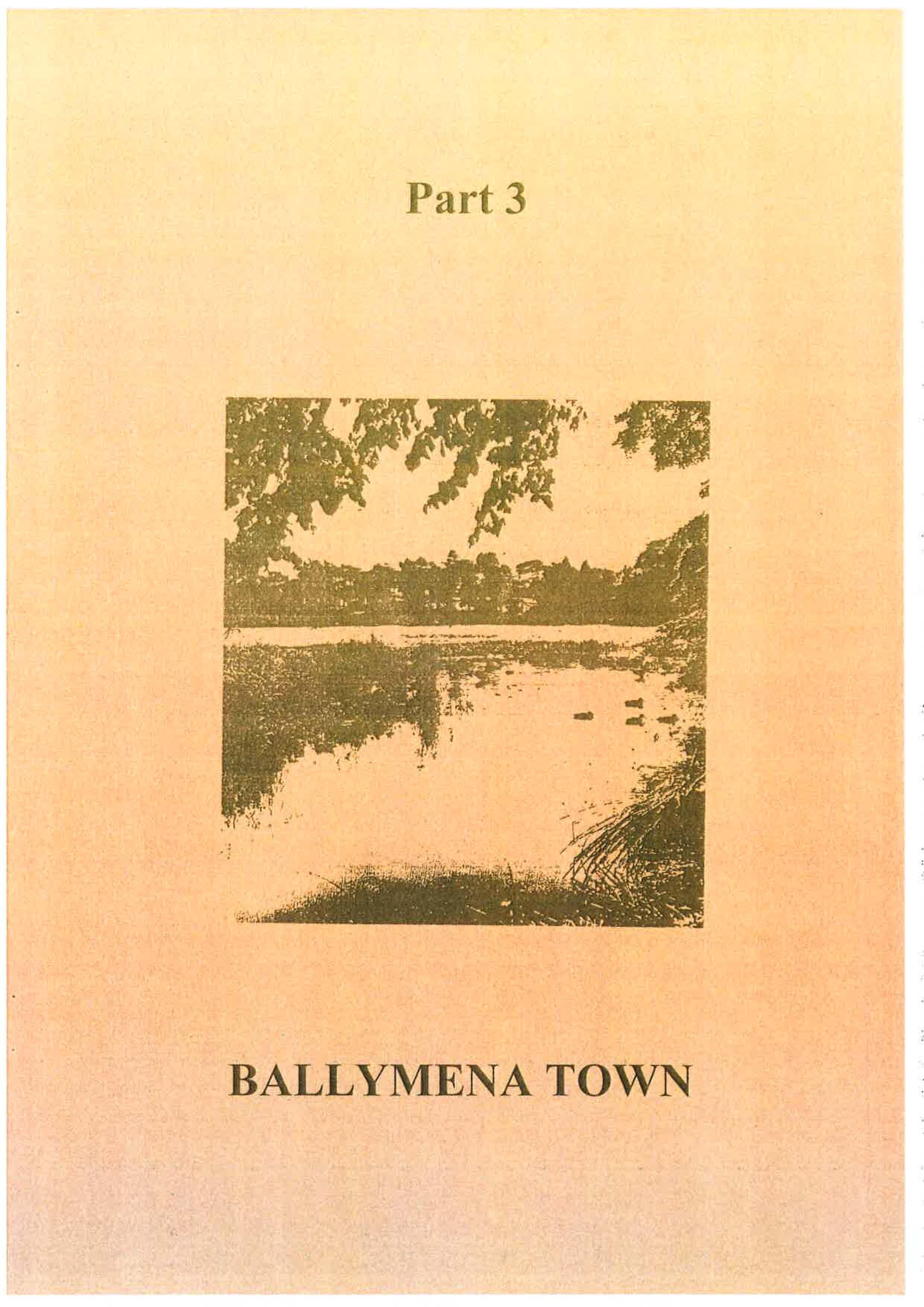
(Map No 2)
16.0
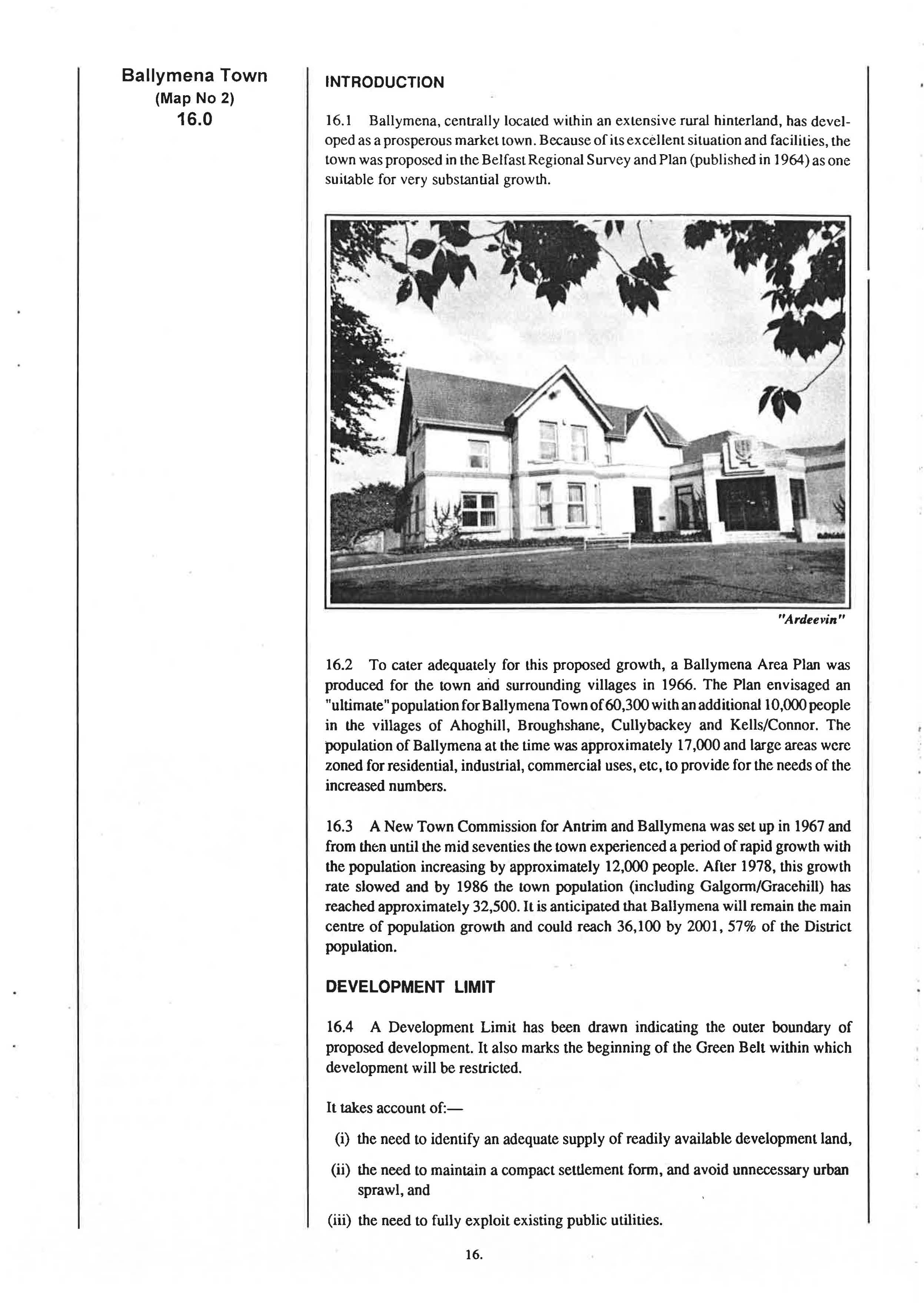
16.1 Ballymena, centrally located wiLhin an exLensive rural hinterland, has developed as a prosperous markeL town. Because of iLs excellent siLuaLion and facilities, the town was proposed in the Belfast Regional Survey and Plan (published in I 964) as one suitable for very substantial growth.
16.2 To cater adequately for this proposed growth, a Ballymena Area Plan was produced for the town and surrounding villages in 1966. The Plan envisaged an "ultimate" population for Ballymena Town of 60,300 with an additional 10,000 people in the villages of Ahoghill, Broughshane, Cullybackey and Kells/Connor. The population of Ballymena at the time was approximately 17,000 and large areas were zoned for residential, industrial, commercial uses, etc, to provide for the needs of the increased numbers.
16.3 A New Town Commission for Antrim and Ballymena was set up in 1967 and from then until the mid seventies the town experienced a period of rapid growth with the population increasing by approximately 12,000 people. Afler 1978, this growth rate slowed and by 1986 the town population (including Galgorrn/Gracehill) has reached approximately 32,500. It is anticipated that Ballymena will remain the main centre of population growth and could reach 36,100 by 2001, 57% of the District population.
16.4 A Development Limit has been drawn indicating the outer boundary of proposed development. It also marks the beginning of the Green Belt within which development will be restricted.
It takes account of:-
(i) the need to identify an adequate supply of readily available development land,
(ii) the need to maintain a compact settlement form, and avoid unnecessary urban sprawl, and
(iii) the need to fully exploit existing public utilities.
16.5 Within the development limit there are areas of undeveloped land which have not been zoned for a particular use. Some of these areas may be physically difficult to develop and some consist of small, individual parcels. The Department will consider sympathetically proposals for developme~t provided the uses are satisfactory for the locations proposed.
16.6 The pattern of population growth outlined in paras 16.l to 16.3 above resulted in accelerated rates of house building and approximately 3,000 dwellings were constructed in Ballymena during the period 1973-86. The majority (approximately 60%) of this house building was carried out by public authorities and at present almost half of the 10,500 dwellings in the town are in public ownership. It is estimated that a further 2,500 sites for new dwellings might be required by the end of the Plan period to accommodate the population expected by 2001.
16.7 Over 150 hectares (370 acres) of residential land, which could accommodate 3,000 dwellings, has been identified inside the development limit. The surplus is provided to offer a degree of flexibility and choice - an important consideration as it is anticipated that growth will be mainly in the private sector. The proposals re-affirm many of the zonings of the 1966 Area Plan although a large residential sector at Ballymena West has been removed as it is unnecessary at the present time.

16.8 The Department has not imposed recommended densities on the proposed housing areas as this is regarded as too inflexible an ~pproach to accommodate the changing requirements of the development proc~. In considering the density appropriate to housing areas the Department will have regard to local conditions including the nature and character of surrounding development. Particular attention will be given to design details concerning the size, siting and layout of proposed residential developments.

16.9 It is difficult to make an accurate assessment of the amount of land which will be required for industrial use in Ballymena during the Plan period. While the availability of land will not generate industrial development, it is nevertheless essential that potential development is not constrained by a lack of zoned industrial land. To this end, approximately 71 hectares (176 acres) of land are zoned for industrial use, divided between Woodside Road - 63 hectares (156 acres) and Galgorm - eight hectares (20 acres). In addition industrial uses may be approved on other sites, for example on unzoned land, provided the proposals are compatible with adjoining land uses, whether existing or proposed.
16.10 Under the Notification of Installations Handling Hazardous Substances Regulations (NI) 1984, a notifiable quantity ofLiquidified Petroleum Gas is stored at Gallaher's, Lisnafillan. The Department in carrying out its development control functions, will continue to consult with the Health and Safety Inspectorate on development proposals in the vicinity of the installation.
16.11 During the Plan period the following Road schemes are envisaged for Ballymena Town:-
1. A26 Antrim/Ballymena dual carriageway, Dunsilly to Bailee.
2. Northern Distributor, North Road to Broughshane Road.
3. West Link Ballymena, Ballymoney Road to Galgonn Road with connection to Old Park Road.
4. South West Ring Road, Bailee to Galgonn Road.
5. Woodtown Road.
The need for individual elements of the proposed highway network will be reviewed in the light of actual traffic growth and changing circumstances.
The Westlink and South West Ring Road are not likely to be implemented early in the Plan period as in general the existing systems of roads within the town will accommodate the anticipated traffic for a considerable time.
16.12 A number of car parks have been constructed during the past 10 years to keep pace with parking demands.
These are:-
Henry Street, Ballymena Church Street, Ballymena
Garfield Place, Ballymena Multi-Storey, Ballymena Ballymoney Road, Ballymena
In addition Coach Entry car park was extended.
Car parking provision will be monitored during the Plan period and additional spaces provided when the need is demonstrated, subject to site identification and the availability of finance.
16.13 In keeping with its role as the major town within the District existing recreation provision is concentrated in Ballymena. At present, the Borough Council has provided a generous amount of fonnal recreational open space well distributed throughout the town. The provision of amenity open space will be augmented by the development of the extensive Civic Park.

16.14 In addition to this the Council intend to:-
(i) develop a major riverside path system throughout the town running from Bridge End, Galgonn to the Seven Towers Leisure Centre and the Civic Park;
(ii) develop a transit caravan park and "Trim Trail" at Ballee Playing Fields.
16.15 Population growth has resulted in the North Eastern Education and Library Board requiring a new primary school and land has been zoned in the vicinity of Galgonn Road for this purpose. Down and Connor Maintained Schools Committee propose to replace the temporary accommodation at St Louis Primary School, Ballymena by a pennanent extension.
16.16 Secondary school enrolment has increased since 1977 but this growth is unlikely to be sustained as primary school enrolment numbers are falling. There are no proposals for additional accommodation at secondary level in either the Controlled or Maintained sectors. The North Eastern Education and Library Board is considering the amalgamation of Ballymena Boys' and Girls' Secondary Schools.
16.17 The North Eastern Education and Library Board propose to develop a new central lending library in Ballymena but a site has not yet been selected.
16.18 The Northern Health and Social Services Board consider existing health facilities to be adequate in the town and it is envisaged that further land will not be required over the Plan period.
16.19 Ballymena Borough Council propose to build two replacement community centres in the town - one adjacent to the playing field al Galgorrn and the other in Ballykeel II.
16.20 Ballymena is fortunate in having a range of features which are of conservation interest. People's Park is an Area of Scientific Interest because of its bird communities. Harryville Motte and Bailey is the only archaeological feature in the District in State Care. The Department designated part of Gracehill as a Conservation Area in 1975, the first in Northern Ireland.
16.21 Development within Gracehill Conservation Area will be controlled with the aim of ensuring the retention of its unique character and the individual buildings, and groups of buildings on which that character depends. Further details of the Department's policies are set out in the "Gracehill Village Conservation Area" booklet.
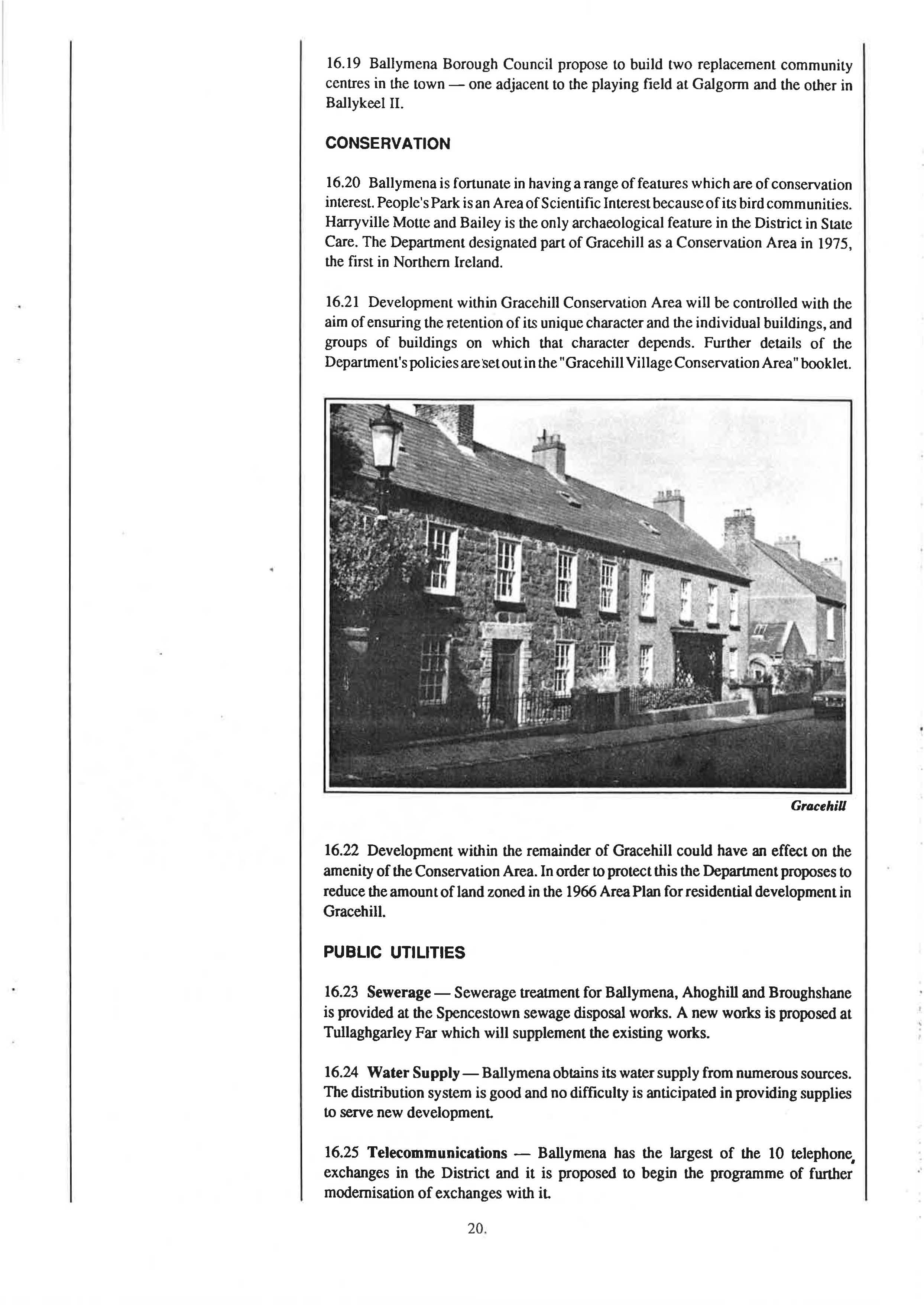
16.22 Development within the remainder of Gracehill could have an effect on the amenity of the Conservation Area. In order to protect this the Department proposes to reduce the amount of land zoned in the 1966 Area Plan for residential development in Gracehill.
16.23 Sewerage - Sewerage treatment for Ballymena, Ahoghill and Broughshane is provided at the Spencestown sewage disposal works. A new works is proposed at Tullaghgarley Far which will supplement the existing works.
16.24 Water Supply- Ballymena obtains its water supply from numerous sources. The distribution system is good and no difficulty is anticipated in providing supplies to serve new development
16.25 Telecommunications - Ballymena has the largest of the 10 telephone. exchanges in the District and it is proposed to begin the programme of further modernisation of exchanges with it
16.26 Electricity - The existing high voltage system has sufficient capacity to service all anticipated development
16.27 Refuse Disposal- The main refuse tip for the town is at Ballymacvea and this has a current life of approximately eight years. When further land is required the Borough Council hope to obtain land adjacent to the existing site.
16.28 Cemeteries- Existing provision at Toome Road has a considerable reserve and the Borough Council have no proposals to extend this during the Plan period.
16.29 Ballymena, as a thriving market town with a centrally located shopping centre, is the focus of business activity in the District and as such its Town Centre accommodates a range of land uses related to its retail and commercial functions. In addition, it has a number of public buildings which, together with recreationaVentertainment and smaller industrial uses (mainly service and warehousing) generate their own forms of activity. The Town Centre therefore, draws people from a wide area which extends beyond the District Council boundary.

16.30 The Department aims to facilitate the development of a vibrant Town Centre encompassing a full range of activities and therefore it is important to ensure that those land uses which need a central area location, can be accommodated. In addition it is considered important to ensure that the physical environment is improved and that new development is of good quality to enhance the appearance of this focal point of the District
16.31 This has been drawn to include both those areas where typical town centre uses predominate at present and tho~e adjoining areas into which such uses may be expected to expand within the next 15 years. The aim has been to provide ample room for expansion and, in particular, to provide a range of sites for possible commercial development to meet the demands created by the ever-changing pattern of retail activity.

16.32 Applications for commercial development, including entertainment and recreational uses, outside the town centre, will be treated on their merits. Proposals close to the town centre in existing buildings or on cleared sites will be given more favourable consideration than those on the periphery of the town on greenfield sites.
16.33 The Town Centre boundary also defines the area within which the Department will foster instruments of urban renewal and as such includes a number of areas with a significant proportion of vacant or underused land and property which are in need of redevelopment.
16.34 A number of possible development sites have been identified and they offer major opportunities for development, particularly of a commercial or retail nature. Residential development may be approved on all or part of some of these sites but preference would be given to commercial or retail proposals. In these areas the Department will seek through the combination of public and private investment to stimulate redevelopment and transfonn the present run-down environment.
16.35 Two of the locations shown, those of Fair Hill/William Street/ Alexander Street, and Salisbury Square/Gilmore Street, encompass a range of existing land uses. The Department's policy will involve these areas being comprehensively planned and the relocation of some uses may be necessary in order to achieve a satisfactory scheme.
16.36 In order to enhance the attractiveness of the Town Centre for pedestrians, the Department proposes to introduce Pedestrian Priority Areas in Greenvale Street, part of Meetinghouse Lane, Pat's Brae, Church Street and Bryan Street. Details of the scheme, which will include the type, number and frequency of vehicles entering the Priority Area, will only emerge after discussions with all interested parties, and will change from time to time in the lightoflocal circumstances and continuing discussion. The impact of these initial schemes will be appraised prior to decisions being taken regarding Mill Street (Lower and Upper), Wellington Street and parts of Ballymoney and Broughshane Streets.
16.37 For new developments on street frontages within the Town Centre the Department will insist on good quality design to ensure a satisfactory relationship with surrounding properties. This will be particularly important on Ballymoney Road and in the area around Broadway where there are significant numbers of listed buildings.
16.38 In dealing with proposals which would lead to the encroachment of non-retail uses at street level into main shopping areas, the Department will have regard to the likely effect of the loss of retail frontage on the attractiveness of these streets to shoppers.
16.39 Whilst the Department wishes to facilitate development in the Town Centre, in certain critical areas the car parking and servicing implications of development proposals will require careful examination. Each proposal will be examined on its own merits and factors to be considered will include the proximity of public car parks and the suitability of the street for dealing with additional service traffic.
22.

16.40 Sites have not been specifically zoned for housing development in the Town Centre and applications for such will be treated on their individual merits. Those which are approved will generally be high density and may require some on-site car parking It is likely that the schemes which result will have a mixture of other land uses in close proximity as the Department will not normally prevent acceptable Town Centre uses locating beside residential development. This should be taken into account when such proposals and designs are being initiated.
16.41 A number of terraces of dwellings within the Town Centre will be retained in residential use. This is to prevent the piecemeal development of individual dwellings for other uses, l.d the detriment of the remainder Proposals, of whatever nature, to develop such terraces "en bloc" will be treated on their individual merits.
16.42 Ballymena is fortunate in having extensive areas of good housing close Lo the Town Centre. It is important that such areas remain in residential use because of the stimulus they give to the vitality of the Town Centre and the Department will seek to prevent the encroachment of other uses into them. Conversion of dwellings into flats will normally be acceptable but the Department will require an element of off-street parking, where land is available within the site, in areas where there is an existing problem with on-street parking.



